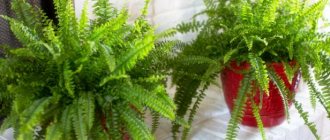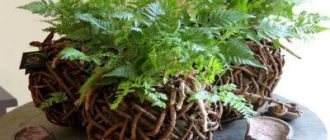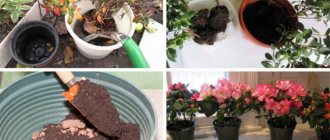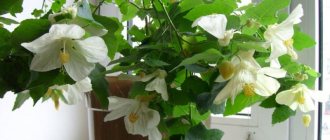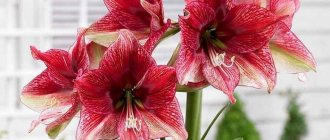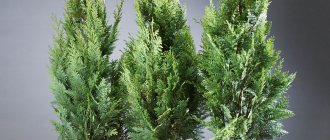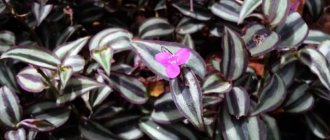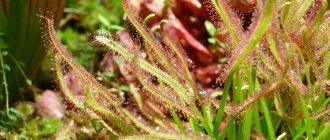Author: Miroslava Danich Category: Houseplants Published: May 16, 2013Last edits: April 15, 2021
The legend about the fern blooming on the night of Ivan Kupala is directly related to our family. My grandfather once in his youth went to the forest at midnight from July 6 to July 7 to see the fern bloom. And he claimed that only evil spirits did not allow him to do this: the wind rose, horses appeared from nowhere and reared up. The grandfather got scared and ran away from that place. Fern is truly one of the most mysterious plants on Earth, if only for the reason that its history goes back millions of years. Archaeological scientists still find fossils with imprints of the leaves of fern plants.
Types and varieties of ferns for home cultivation
There are a lot of varieties of fern, but not all are suitable for growing indoors. Among the home collections you can find the following types:
- Maidenhair. It has thin, slightly translucent leaves of light green color on graceful black stems. Suitable for growing in damp and cool areas.
- The common ostrich is distinguished by its original leaves, similar to the feathers of ostriches.
- Orlyak. This plant can grow up to 70 cm in length, its leaves are hard and single. It is considered a medicinal type of fern.
- Nephrolepis is beautiful, quite large, its leaves are hard, long, light green. In some plants they grow vertically, eventually drooping, in others they are wavy, immediately drooping down. There are many varieties of this variety. They are the ones most often chosen for growing at home.
- The male shield plant is a powerful large plant with light green leaves. It is considered poisonous, but healing.
- Female kochedyzhnik is distinguished by openwork, dissected leaves; in everyday life it is often used to fill aquariums.
Attention! Nephrolepis varieties are usually chosen for growing at home. These flowers are beautiful, hardy and relatively easy to care for.
Female kachedyzhnik (Athýrium fílix-fémina)
Male shieldweed (Dryopteris fílix-mas)
Nephrolepis
Bracken (Pteridium aquilinum)
Ostrich (Matteuccia struthiopteris)
One of the rarest ferns - polypodium
Polypodiums, or Centipedes, are ancient ferns from the family of the same name, Centipedes (Polypodiaceae). Their name, like their appearance, has not changed for thousands of years. Polypodiums are often confused with Phlebodiums, and changing the classification with the transfer of individual species from one genus to another does not simplify the situation.
But Polypodiums remain the rarer, less extravagant and very special character rare ferns that deserve special status and treatment.
In Europe, centipede ferns are often called sweetroot. But still, translated analogues of the botanical name are much more popular. In nature, centipedes prefer to settle in the Southern Hemisphere. Some species are found in Australia and New Zealand, in southern India, and in South America. This forest plant most often chooses dense forests and jungles with high humidity and fairly secluded lighting; it grows on bushes and trees.
The structure of this fern is often compared to water lilies, emphasizing how atypical a member of the fern class Polypodium actually is. But it is more appropriate to call it an original culture, rather than looking for analogies with aquatic plants.
Polypodiums are characterized by special rhizomes - creeping, scaly, horizontal rhizomes with fairly thick adventitious roots. The rhizomes of polypodiums differ in size and rhizome character. Some polypodiums have thin roots, others have thicker and fleshier roots, but they are easily recognizable by their horizontal arrangement and characteristic scales on the surface. Polypodiums do not form a stem; leaf petioles remain very important organs for them.
All polypodiums grow quite quickly, actively growing in indoor conditions and producing several new leaves annually. They develop in a horizontal plane, gradually spreading, which should be taken into account when choosing a location and when searching for a container or method of cultivation. This is one of the fastest growing types of ferns for growing in rooms and greenhouses, capable of achieving maximum decorative value by the third year of cultivation.
From the upper part of the rhizomes, in rows, on fairly long, segmented petioles, large fronds of leaves develop. The maximum height of polypodium leaves is about 100 cm, although most species are limited to much more modest sizes up to 50 cm in height, and indoor plants are most often compact epiphytes up to 40 cm in height.
Pinnately divided or pinnately dissected, they are distinguished by their dense texture, asymmetrical shape of the lobes and, most often, free veins. The segments are lanceolate or almost tongue-shaped, irregularly wavy, most often with a solid edge and a rounded tip. The leaves of polypodiums unfold very beautifully, from a peculiar shell-like shape they stretch into a tight spiral and then straighten out their lobes.
In some polypodiums the leaves are green, quite dark or brighter, in others they are covered with a bluish coating or uneven, barely visible spots, with thinner or wider, curved or almost straight lobes. The variety of colors in greenhouse and indoor culture is particularly striking.
Sori of polypodiums are formed quite actively and over almost the entire reverse surface of the leaves. They are located closer to the edge of the leaf plate, between the veins, large and round, not covered by a spathe.
Centipede fern, or Polypodium polypodioides. Ransomed63
Fern in a pot - indicator of indoor microclimate
Fern is considered a resilient plant, however, some rules of care and conditions for its good growth must be observed. And if in nature the plant will grow wonderfully in sandy or peaty soil, and will do well without replanting and pruning, then in an apartment, even in the most ideal soil, it can begin to wither. The reason for this may be an unfavorable indoor microclimate.
The fern is sensitive to the atmosphere in which it is located, and is a kind of litmus in determining the purity of the air. Ferns begin to die and get sick in conditions of gas pollution and smoke in the environment. They do not tolerate too dry air well, so one of the main conditions for the growth of this plant is good access to fresh air.
Poor growth and slow death of ferns is a reason to think about the environmental situation in your house or apartment. It is likely that there is a gas leak in the house, or it is time to buy a kitchen hood. It is also worth checking the humidity level: it may make sense to purchase a humidifier.
Important! If, despite following the basic rules of care, the fern continues to wither, it makes sense to think about the quality and humidity of the air in the room. Ferns react sharply to gas pollution and low humidity levels.
Why do leaves dry out and turn yellow?
Most often, plants suffer from physiological diseases, which are the result of inadequate care for house ferns. What should you pay attention to?
In particular, it should be a cause for concern when the tips of the leaves begin to turn yellow and the rest of the leaf becomes a poor color. The cause may be too much watering, which causes root rot, or low air humidity.
If such alarming symptoms appear, diseased leaves are removed at the very base. After pruning, you need to eliminate the mistakes made, allow the plant to recover and continue to care for it correctly.
Drying leaves on a fern
A fern can also dry out due to an attack by pests or diseases, but they do not play a big role in the life of these plants. If ferns are exposed to low temperatures for a long time and the air humidity is high, they can become infected with fungus. In this case, round or oval gray-brown spots appear on the leaves, sometimes surrounded by a border. Leaves infected with fungus should be removed and destroyed, then the plant should be sprayed with fungicides.
The most common pests are scale insects; they feed on the underside of the leaf, sucking the juice from it. The leaves become covered with yellow spots, then turn yellow completely and die. Damaged leaves should be cut off and the entire plant should be treated with insecticides.
Another reason for fern drying out is poor watering. In this case, it can be revived by immersing the pot in a large container filled with water and leaving it there for 15-20 minutes. Repeat the procedure for several days.
Ferns and their species are popular as houseplants due to their easy care and excellent decorative capabilities. Although there is no flowering, they grow very quickly, and the mistakes of novice gardeners can do little harm.
Fern home care at home
Varieties of nephrolepis are not only hardy, but also decorative, so they will perfectly decorate the interior of a house, apartment or office space. Depending on the lighting and the composition of the soil in the pot, the color of the leaves can vary from delicate light green to rich green.
Lighting, location, temperature
The plant adequately perceives shadow, so it can be placed even in the corner farthest from the window. But this does not mean that it does not need light at all: scattered sunlight should fall on the leaves. If there is a place in the corner opposite the window or at the south-west window opening, it is better to give it to the fern.
The perennial plant is quite large in size, growing gradually both in height and width. It is unlikely that it will be possible to place it on a windowsill; it needs space.
The ideal air temperature for indoor ferns is about 20 degrees. Theoretically, the plant can withstand a jump of up to 12 degrees, but there is no point in doing such an extreme on purpose.
Watering and spraying
The fern prefers moderate, and most importantly, regular watering. The soil in the pot where nephrolepis grows should always be slightly moist, but at the same time not waterlogged. If you ignore this point, first dry it and then pour it abundantly into the flower, you can provoke rotting of the fern roots. Watering the flower two or three times a week will be quite enough, and you should also spray it. Rainwater or soft, settled water is suitable for irrigation.
If the air in the room is too dry, you will have to spray the plant more often - every day. In moderate humidity, two or three times a week is enough. Watering and spraying can be combined or alternated between these procedures.
Attention! Moderate regular watering with soft water (temperature about 20 degrees) and a little sunlight are the main conditions for plant health.
The soil
For planting and further good growth of the nephrolepis fern variety, you need soil that is similar in structure and composition to that to which the plant is accustomed in nature: loose, with rotted leaves, pine needles, and peat residues.
The soil for planting should be slightly acidic, ideally with admixtures of sand and humus, as well as turf, peat, and leaf soil. Mandatory conditions are water permeability and looseness of the substrate.
In compacted soil, water can stagnate and the roots can begin to rot. As a result, the plant will get sick and die. The first sign of soil that is too wet is brown or brown spots on the leaves. Subsequently, you can even see the leaves drying on the fern. The same signs will appear if the air or soil is too dry.
Top dressing
Experts assure that ferns do not need to fertilize too often: twice a month will be enough. Mineral or organic fertilizers will be quite suitable for feeding. With the latter, you can make a mistake and dilute too concentrated a solution. It is better to dilute minerals according to the instructions.
Know! The best soil for ferns is with admixtures of peat, humus and sand.
Lighting
Decorative fern is one of the few indoor plants that feels great in the shade. The fact is that in the wild, ferns grow in the lowlands of tropical forests - where light rarely reaches. However, in order for the fern leaves not to become coarse, but to have a more attractive appearance, sunlight in small quantities is necessary. Therefore, it is ideal to place a pot of fern in the western room - there, at sunset, the plant will receive the lighting it requires for the day.
The fern can also be placed or attached to the wall in the bathroom - although there is no daylight there, there is good humidity (see the section below about this).
Transplantation and propagation
Ferns of any variety and type can be replanted every year. In order not to harm the roots, it is better not to replant, but to replant the flower. When replanting, you need to take a pot a couple of centimeters larger, carefully, without injuring the roots, transfer the flower with soil into it and add the earthen mixture. The best time is the beginning of the growing season, that is, spring. During autumn transshipment, the plant may take a long time to take root, and may even get sick.
If the bush is large and daughter bushes have already appeared, the fern can be divided, thus propagating the plant. It is better to create greenhouse conditions for small plants. There is a possibility that the new daughter shoot, even if it has a root, will not take root. Despite this, this method is the most convenient for reproduction.
Seed propagation (by spores) is a complex process and is not possible under indoor conditions, but Chelyabinsk gardeners have already learned to propagate ferns by seeds. Watch the video to see how the process of seed propagation occurs.
Description of the plant
Fern (Polypodiophyta) is an ancient plant with a multimillion-year history, numbering more than 300 genera and 10 thousand varieties. Only a few of its varieties are grown in apartment conditions:
- nephrolepis;
- maidenhair;
- polypodium;
- platicerium;
- pellea.
This lush indoor flower with a thick spherical or spreading crown consists of two parts: a not too powerful rhizome and feathery openwork leaves, scientifically called fronds. The arc-curved leaf blades differ in shape and size among different varieties; they come with dissected or whole leaves. The indoor fern does not have flowers or fruits, but spores are successfully formed on the underside of the leaf.
Many owners of fern-like crops value these plants for their healing properties and ability to cleanse the air of dust. However, if left in a dusty and polluted room for a long time, the fern begins to wither and may even die. Another feature of the evergreen flower is the structure of its leaves. Young, unopened leaf plates grow tightly curled into a spiral, then acquire a darker shade, become dense, and almost completely straighten.
It is important to know. When using the roots of the plant to treat eczema, you must remember that the rhizomes are poisonous, and failure to follow the decoction recipe can cause poisoning.
Trimming
Each part of the plant is very important in the life of the entire plant, so pruning the fern should only be done in emergency cases if:
- parts of the plant are injured or damaged (for example, by sunlight or cold air);
- the plant is damaged by insects or disease;
- there is a need to stimulate the growth of fresh foliage.
If pruning still needs to be done, it is better to do it not at the peak of growth. For an indoor fern, 1-2 trimmings per year is sufficient. Old leaves that have turned yellow from time and age of the flower should be cut with pruning shears or garden shears. There is no need to trim tendrils or parts of roots that hang down. If you want to make them invisible, you can twist them and “hide” them in a pot, above the soil, securing them with wire.
Please note! The best option for propagating a flower at home is to plant a large plant. Reproduction by spores is an extremely complex process.
Temperature compliance
The belonging of such vegetation to a certain species requires the provision of appropriate conditions. In extreme heat, the optimal permissible values for a plant are up to 30° C. But how to care for a fern if the plant is exposed to higher heat levels? It must be limited from direct exposure to the sun, watered in a timely manner and constantly moistened by sprinkling.
A good idea is to move the fern indoors into the open air. Before the onset of cold weather, the gardener must take care of a cool place for the plant in the room. Each species is suitable for a different temperature, some feel comfortable at 17° C, others feel comfortable at 14-16° C. Optimal indicators are + 10° C. A colder room can negatively affect the roots if they are in wet soil. Hypothermia may occur.
At home, caring for a houseplant is not difficult if you follow the rules. To create a favorable climate, you need to place the pot on a windowsill, the window of which is located on the east or southwest side. This will help protect the crop from the harmful effects of the sun and provide the optimal amount of light for its growth and decorative effect.
To protect plants from the influence of a polluted atmosphere, the location of the flower should be away from the balcony facing a street with heavy traffic, and far from the place chosen by the smoker.
Problems with growing ferns at home
Having planted a house fern, you need to understand that only high-quality care at home will minimize its diseases and will guarantee that pests will bypass a healthy and strong flower. One of the causes of disease and weakening of ferns is violation of watering rules.
Many gardeners note: at some point they discovered that the leaves on the flower turn yellow or brown spots appear on them. In this case, the destructive process begins from the edges, and the entire leaf gradually disappears. But the disease should not be confused with the natural process of dying off old leaves.
Improper watering can also cause nematodes to appear in the soil. In this case, the plant can only be saved by replanting and changing the soil, and even then not always. The insect settles in foliage and rhizomes, so it is extremely difficult to rid the fern of it. One of the drugs that helps in the treatment of this pest is a solution of the drug “Ateplik”.
Unsuitable, too dry air can cause the appearance of aphids, thrips, and scale insects. As a preventive measure against these pests, you need to regularly spray the plant. If infection occurs, you can try spraying it with a solution of Karbofos or the same Aktelik.
Important! The process of dying off of old foliage should not be confused with fern disease or the effect of pests on everything, including very young leaves.
Excessive sunlight can cause foliage to become faded, combined with brown spots. The pallor of the leaves will indicate, on the contrary, its deficiency or lack of nutrition for the plant.
The cause of poor growth will most likely be a small pot, and blackening and rotting of the foliage will appear due to a fungal infectious disease of a plant such as indoor fern. Photos published by amateur and professional flower growers on the Internet will allow you to more accurately determine what exactly your flower is sick with.
How to properly water indoor ferns?
Excess moisture is detrimental to them, as it disrupts normal air exchange in the soil. With excess moisture, the roots gradually die, the leaves turn yellow, wither and droop without restoring their previous position. It is necessary to reduce watering.
The need for watering can be determined in several ways. Dried soil is lighter than wet soil. However, if the plants are planted in peat, it is not enough to be guided by this sign alone. Most often, the soil is checked by touch (it should be slightly damp, crumble, and not stick to your fingers). The need for watering is also determined by the sound when tapping on the wall of the pot (if the sound is dull, it is too early to water).
Particularly abundant watering is recommended for ferns during growth, that is, in spring and summer. Even with slight drying out, young shoots may die. The need for watering should be checked daily, and in the summer, in hot weather, in the morning and evening. The main watering is best done in the first half of the day . With each watering, the fern needs to be given enough water so that it thoroughly wets the entire earthen lump and flows onto the saucer. If there are air bubbles on the surface of the soil, repeat watering until there are none. It is not recommended to water ferns a little every day, since in this case the water will only wet the top layer of soil, and the roots will not receive enough moisture.
Ferns need to be watered from above so that the excess calcium, magnesium and other elements contained in the water, which is harmful to the root system, is absorbed by the top layer of soil, which contains fewer roots. The high content of calcium salts in water leads to the fact that the most important nutrients found in the soil (phosphorus, iron, manganese, aluminum, boron, etc.) turn into compounds harmful to plants.
The water from the saucer is drained after watering so that the roots do not rot from excess moisture. This is especially important to do in autumn and winter.
If water does not fall onto the saucer when watering, but remains on the surface, you need to check whether the drainage hole is clogged. Sometimes, on the contrary, water flows out onto the saucer very quickly. This means that the soil is very dry, and therefore water flows down the walls of the pot without having time to wet the soil. In this case, the fern needs to be watered generously and sprayed.
Folk signs and beliefs about ferns
Many flower growers and florists do not lose sight of various folklore signs. Regarding fern, they differ radically: some claim its positive effect on the spiritual atmosphere in the house, others say the opposite. It’s better to be optimistic and not give up on growing this flower at home. This is what the popular voice prophesies to the owners of the fern:
- Peace and quiet. If there is a fern in the house, there will be no temper and aggression here, the residents will become softer and more tolerant, friendlier and more restrained. The plant will have the same effect on the atmosphere in the house as a whole.
- Harmony in relationships. This is especially true for families whose members have different temperaments. Thanks to the fern, experts say, people will get along even better, and harmony and happiness will reign in the family.
- Good luck in all your endeavors. Fern attracts fortune and material success, even sudden wealth to the most gamblers. The plant will protect against waste and make its owner lucky.
- Amulet. They say that fern is able to scare away all evil spirits from the house, protect against witchcraft and magic, and become a family amulet.
Important! The fern will give harmony and peace to the home, improve relationships between family members and attract good luck to the owners.
Read : Fern in the house signs
Fern is a beautiful, elegant, and also useful plant in any everyday life. It will not only decorate the interior and make it cozy, but will also be useful. On the one hand, any greenery in the room is a natural source of clean air; for a living or work space this is a more than important factor.
On the other hand, a fern is an indicator of the state of the atmosphere in an apartment or office. And if you believe folk superstitions, fern bushes will have a positive impact on the harmony and well-being of the family in whose house the fern grows.
Varieties
There are not many species of fern-like plants grown at home.
- Maidenhair. A plant with thin but strong stems and graceful fronds loves warmth, shade and moisture. Adiantum is better grown in winter gardens and terrariums than at home. The names of Adiantum varieties are raddy, tender, fine-haired, lady's hair.
- Asplenium. Loves shade and moist air. At home, several varieties of asplenium are bred, which in appearance are completely different from each other. This is a nesting and bulbous asplenium, viviparous.
- Nephrolepis. The plant loves space and does not tolerate neighbors. The fronds of nephrolepis are strongly dissected, which creates a unique openwork effect. The most commonly grown variety is Nephrolepis sublime, which is quite easy to care for at home. Nephrolepis also reproduces simply - by dividing a large bush or by shoots.
- Blekhnum (otherwise known as derbyanka). The crown of the plant reaches a diameter of about 1 m, and the rigid fronds look like a palm tree. The most common varieties are Blechnum humpback and Brazilian.
- Davallia. A plant with a very thick rhizome. Because of this feature, it was given the popular name hare's or squirrel's feet.
- Platycerium (aka plateau). The plateau is characterized by the presence of large, showy leaves divided into lobes that look like deer antlers.
- Disconia. A small young plant can reach 3 m in adulthood, suitable for spacious interiors.
- Pelley. Pellea loves dry habitats, which distinguishes it from other species. The most common varieties of pelley are round-leaved and green.
- Polypodium (aka centipede). A plant with heavily dissected leaves has two features: a rhizome creeping along the surface and the ability to grow in places with dry air.
Varieties
Plants such as ferns have the following types and names:
- Nephrolepsis. The most recognizable and widespread. We love it very much in public institutions (schools, libraries, theaters, etc.) for its unpretentiousness. It has beautiful openwork leaves up to half a meter long, collected in a rosette.
- Platycerium. A very unusual multi-horned species. It is a plant that resembles a head of cabbage, from the center of which flat carved leaves protrude in different directions. Moreover, in the middle it has a reddish tint, and the splayed leaves resemble deer antlers.
- Davallia. The shaggy, brownish aerial roots hanging from the pots give this plant an interesting look. Due to the delicate silvery edge, the roots look like paws, for which the plant received the name hare's feet or rabbit's feet. The leaves are openwork, toothed, bright green. Towards the end of the growing season (autumn) they gradually turn yellow.
- Asplenium. Uncut wavy leaves form a rosette that looks like a bird's nest. The plant hates having its leaves touched.
- Polypodium. It has a thick, scaly and creeping rhizome, on which strongly dissected, feathery leaves grow in rows.
- Blekhnum. A rather capricious fern, indoor care for it is somewhat more difficult than for other species. Has a clear resemblance to a palm tree.
- Pelley. A small plant (up to 25 cm) with original, round or ellipsoid leaves.
- Maidenhair. Popularly called Venus hair for its very delicate, delicate, light green leaves, similar to long wavy curls.
There are a great many varieties of ferns. There are more than 10,000 species, but not all are bred as indoors.

